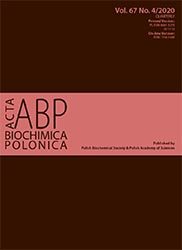In-vitro activity of lipoic acid against Ureaplasma urealyticum and Ureaplasma parvum isolated from women with infections of the urogenital tract. A pilot study
Abstract
Several species of Ureaplasma bacteria are known to be present in the urogenital tract of humans, in both healthy individuals and symptomatic patients. These pathogens are associated with urogenital tract infections, infertility problems and spontaneous abortion in humans. The present study involved 77 strains of Ureaplasma species (Ureaplasma spp.), including 21 Ureaplasma urealyticum (U. urealyticum) strains and 56 Ureaplasma parvum (U. parvum) strains. Lipoic acid (LA) and its reduced form dihydrolipoic acid (DHLA) are synthesized in all prokaryotic and eukaryotic cells. Research of recent years increasingly points to therapeutic properties of exogenously supplemented LA. In our study, we examined for the first time the effect of LA on the bacteria multiplication and its bactericidal activity against U. urealyticum and U. parvum. The LA concentrations used were: 1200 µg/ml, 120 µg/ml, and 12 µg/ml. The titer for each strain of Ureaplasma spp. was estimated using the color changing units (CCU) assay. For CCU measurements, a series of 10-fold dilutions of each cell culture in 0.9% NaCl (titration) was prepared and 1 CCU/ml was defined as the highest dilution of cells at which color change was detected. The strongest bacteriostatic and bactericidal effect of LA was observed at a concentration of 1200 µg/ml. In contrast, at lower LA concentrations, stimulation of the bacteria multiplication was noted for 14% of the total number of strains tested. Taken together, the current data provide novel findings about potential beneficial antimicrobial effects of LA.
Acta Biochimica Polonica is an OpenAccess quarterly and publishes four issues a year. All contents are distributed under the Creative Commons Attribution-ShareAlike 4.0 International (CC BY 4.0) license. Everybody may use the content following terms: Attribution — You must give appropriate credit, provide a link to the license, and indicate if changes were made. You may do so in any reasonable manner, but not in any way that suggests the licensor endorses you or your use.
Copyright for all published papers © stays with the authors.
Copyright for the journal: © Polish Biochemical Society.


